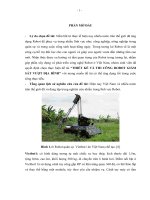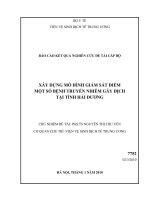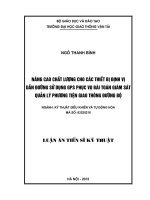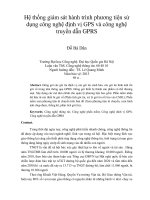GIÁM SÁT ĐIỂM ĐỊA PHƯƠNG OHIO ENGLISH LANGUAGE PROFICIENCY ASSESSMENT (OELPA) CHO BÀI KIỂM TRA NÓI
Bạn đang xem bản rút gọn của tài liệu. Xem và tải ngay bản đầy đủ của tài liệu tại đây (728.43 KB, 13 trang )
<span class="text_page_counter">Trang 1</span><div class="page_container" data-page="1">
<b>Ohio English Language Proficiency Assessment (OELPA)</b>
Local Scoring for Speaking Test
</div><span class="text_page_counter">Trang 2</span><div class="page_container" data-page="2"><b>After viewing this tutorial, test administrator* (TA) should be able to:</b>
•Conduct the scoring procedure
•Use rubrics to consistently assign score points
•<sub>Employ holistic scoring to make appropriate </sub>
scoring decisions
*
TA must meet criteria<b>Tutorial Objectives</b>
<small>2</small>
</div><span class="text_page_counter">Trang 3</span><div class="page_container" data-page="3"><b>Local Scoring OverviewInstructions for TA:</b>
• Speaking test scored “live” with one student and one TA in a room
• TA assigns scores and records scores in the Data Entry Interface (DEI)
• Scores may be entered in the DEI at the time of testing, or after all student testing is completed, but before the test window closes on March 31<small>st</small>.
• The DEI Manual and a DEI Tutorial have been posted on the Portal.
• One student with one TA in one room – failure to follow one-to-one rule results in test being administered
again to one student with one TA
</div><span class="text_page_counter">Trang 4</span><div class="page_container" data-page="4"><b>Required Materials</b>
<b>TA will need for the speaking test:</b>
<i><small>• Directions for Administration Paper-Pencil Manual which </small></i>
<small>• Script to be read aloud to the student;</small>
<small>• Introductions to each audio track on the CD; and • CD containing audio stimuli; and</small>
<small>• Test booklet for the student</small>
<small>• Speaking Local Scoring Document (includes the Rubric used to score the student response, and specific instructions for the DEI.)</small>
<small>Please note the student may listen to the CD track as often as needed and may respond as often as needed.</small>
</div><span class="text_page_counter">Trang 5</span><div class="page_container" data-page="5"><b>Student’s ResponseInstructions during test:</b>
• Student listens to the question/task;• Student gives oral response;
• TA writes student response in the test booklet;• TA reviews student response and scores;
• TA enters score into DEI (when scores are entered into DEI is determined by the TA as long as it is
completed before the test window closes on March 31
<small>st</small>).
</div><span class="text_page_counter">Trang 6</span><div class="page_container" data-page="6"><b>Scoring DecisionsHolistic Scoring:</b>
• Gives student a single, overall score for the response as a whole;
• Balances strengths and weaknesses among the various criteria described in the rubric; and
<b>• Does not depend on the exact number of errors or </b>
assign a score for each detail.
</div><span class="text_page_counter">Trang 7</span><div class="page_container" data-page="7"><b>Scoring Decisions</b>
<b>Holistic Scoring of Clustered Questions/Tasks:</b>
• Responses should be scored holistically across all parts.
• Significant grammatical errors in some responses in the set could reduce the overall score based on the degree to which it interferes with scorer
understanding.
</div><span class="text_page_counter">Trang 8</span><div class="page_container" data-page="8"><b>Scoring DecisionsRubrics</b>
• 2 point – student response addresses the
question/task but errors/lapses obscure meaning
</div><span class="text_page_counter">Trang 9</span><div class="page_container" data-page="9"><b>Scoring DecisionsRubrics</b>
• 2 point – student response addresses the
question/task but errors/lapses obscure meaning
</div><span class="text_page_counter">Trang 10</span><div class="page_container" data-page="10"><b>Scoring Decisions</b>
<b>Rubrics</b>
</div><span class="text_page_counter">Trang 11</span><div class="page_container" data-page="11"><b>Scoring DecisionsRubrics</b>
Either a 3 or 2 point rubric:
• 1 point – student responds with a word or phrase that can be tied to the question/stimulus or
response barely answers the question
• 0 point – student response does not address communicative demands of task/question
</div><span class="text_page_counter">Trang 12</span><div class="page_container" data-page="12"><b>Scoring DecisionsRubrics</b>
<small>Specific Student responses that would result in a score point of 0:</small>
<small>• Student response is only in a language other than English;• Refusal/Blank – student does not give a response or student </small>
<small>response of, “Yes, No, I don’t know” </small>
<small>• Off Task/Topic – student response is not related to question/stimulus</small>
<small>• Unintelligible – student response does not make sense</small>
<small>No score given - Technological Issue – student cannot respond as the CD or CD player does not work and question/task needs to be readministered when replacement CD obtained</small>
</div><span class="text_page_counter">Trang 13</span><div class="page_container" data-page="13">








